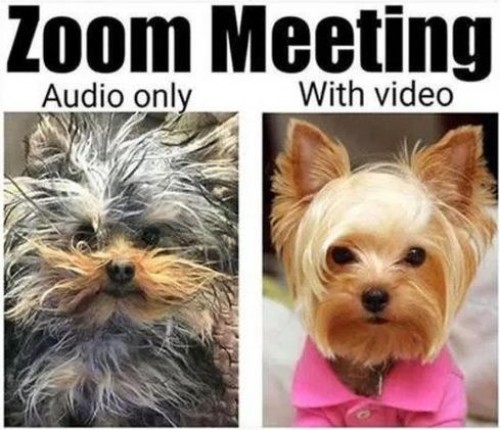 The current “Social Distancing” and “Shelter at Home” requirements have resulted in millions of people conducting virtual presentations for the first time.
The current “Social Distancing” and “Shelter at Home” requirements have resulted in millions of people conducting virtual presentations for the first time.
And it shows.
Which is understandable. Our first attempts at most things leave a lot to be desired. And virtual presentations have a lot more challenges and elements to be managed than typical presentations. I should know—I’ve been conducting webinars, eLearning courses, web conferences, and online sales presentations for more than twenty years. (Remember back when dial-up was still a thing?)
I’ve learned a lot over that time. (Much of it, the hard way.) So let me share with you a few strategies, tips, and tricks for knocking your next virtual presentations out of the virtual park.
1. Set and manage expectations
Is it a webinar or a meeting? How long will it last? What is the goal? Who will be allowed to talk and for long?
2. Start on time
Starting late punishes those who log on early and encourages everyone to be late in the future.
3. Engage participants before start time
To incentivize people to log in early, provide entertainment or information to early arrivals. Play a game or hold a contest with prizes.
4. End on time
The only thing attendees hate more than starting late is ending late. Plan on less time than you have to allow for questions, tangents, and technical glitches. And because your slides or presentation platform can cover up the clock on your screen, keep a separate clock in your line of sight.
5. Get the light right
Arguably nothing makes a bigger difference in how you’re perceived than how you’re lit. You want enough light on you to be seen clearly, but not so much that you’re washed out. I have a large window in front of my desk, and I have to close it for presentations because even the ambient light is too much. Go for artificial light—preferably a wide source of dim light. Avoid using one or two bright bulbs, because that will result in “hot spots”—bright areas on your cheeks, nose, and forehead.) Also, make sure you aren’t backlit—close the blinds or curtains on any windows in the room and turn off lights aimed in the direction of your camera.
6. Enable your video
The whole point of optimizing your lighting is so you can be seen, which is one of the most important elements of a video conference. Don’t just show people your PowerPoint slides, let them see you.
7. Check your sound level
Besides being seen, you also need to be heard. So check your sound levels in advance.
8. Upgrade your audio and video
While we’re on the subject of being seen and heard clearly, you may want to consider investing in an external camera and microphone. Both will significantly improve the technical quality of your presentations.
9. Mute mics when you don’t actively want conversation
Although you want to be heard, you don’t necessarily want everyone to be heard. So if you’re doing a webinar, or some other type of presentation to a large or medium-sized group, mute everyone’s microphone. Don’t depend on the attendees to do it, because invariably someone will forget. On the other hand, if you’re talking with only a few people and you want to encourage conversation, then leave everyone’s mic open. (But let them know their mics are live unless they mute them.)

10. Look at the camera
It’s natural to look at your slides, or the video feeds of your participants, or—especially—the video of yourself as you talk. But that means you’re not making eye contact with your virtual audience. Make an effort to look at the camera instead.
11. Raise your computer
Speaking of looking at the camera, are you looking down at it? Most people do, which shows off your nostrils and emphasizes your double chin. (Well, not your double chin. Other people’s.) Put your laptop on a stand, a raiseable desk, or a cardboard box (super high-tech) to elevate the camera to eye level.
12. Practice “Social Video Distancing”
If you’re too close to the camera, your audience sees only your eyes and nose. If you’re too far away, your audience can neither see nor hear you well. Shoot for roughly the top third of your body in frame, which is typically about an arm’s length from the camera.
13. Hardwire your computer to the internet
Wi-fi is great and all, but sometimes it can slow down or even go out entirely without warning. Using a hardwired connection guarantees you more reliability.
14. Learn your platform
Whether you use Zoom, GoTo Meeting, Microsoft Teams, or something else, learn the ins and outs of it. There are plenty of tutorials online.
15. Make it interactive
Every platform has options for encouraging interactivity. You can present polls, ask participants to raise their hands, or divide them into breakout groups. You can also ask questions and either have them type their answers in the chat or voice the answers while you record them on a digital whiteboard.
16. Understand your security settings
There have been reports of virtual meetings being hijacked and other dangers of online meetings. Learn your platform’s security settings and use them.
17. Use large type on your slides
You don’t know what kind of device your attendees are watching your presentation on. It could very well be a tablet or a phone. And even if they’re watching on a laptop or desktop, they may not be using their full screen to look at your slide deck. In both cases, if your text isn’t huge, they won’t be able to read it at all. (One more reason you don’t want to fill your slides with lots of text.)
18. Use minimal animation on your slides
Lag time means your animations won’t be fast or smooth. So keep them to a minimum. Or don’t even use them at all. Trust me, nobody will notice. (“Did you see those animations? Those were awesome!” said no one ever.)
19. Prep your computer
The less your computer is doing, the better. So close other programs, clear your cache, and reboot in advance of your presentation.
20. Eliminate noisemakers
Silence your cell and your landline. (Along with your fax and your pager, of course.) And mute or turn off anything else in the room that might conceivably make a noise.
21. Make sure everyone else knows you’re on a call
On the same subject, let your family—or your colleagues—know not to disturb you. Because if you don’t, there’s a 100% certainty that your kids will choose that exact moment to challenge the dog to a bark-off, bang pots and pans together, or practice their trombone for the first time in weeks.
22. Let attendees know if you’re recording
If you’re recording the presentation, warn your audience so they have the option of turning off their video in the event they don’t want to be preserved for posterity.

23. Get to the point quickly
Don’t waste your audience’s time. Keep in mind that it’s easier for online attendees to tune you out and focus on other things. If you lose them in the first few minutes, you’re not getting them back.
24. Amp up your enthusiasm
As important as enthusiasm is in a live, in-person presentation, it’s even more important in a virtual one. Your participants can’t feel your energy, so they need to really see and hear it.
25. Remember—the rules of good live presentations still apply
What works in person still works online:
a. Open with something attention-grabbing
b. Your slides are not your presentation
c. Tell stories
d. Use appropriate humor
e. Appeal to both logic and emotion
f. Use visuals
g. Include a call to action
h. Close memorably
26. Have someone else monitor the chat
It’s nearly impossible to pay attention to the chat window while you’re presenting. But used effectively, the chat is a great forum for ideas, comments, and questions. So arrange for another person to monitor the chat and to alert you when something is worthy of attention.
27. Upload additional files
Most—if not all—platforms have the ability to upload files that participants can download during the presentation. Use this feature to easily distribute handouts, articles, proposals, contracts, photos, videos, or even your slide deck exclusively to attendees.
28. Rehearse and practice
Want to deliver a good virtual presentation? Rehearse. Want to deliver great virtual presentations consistently? Practice! (Bonus tip: Record your practice sessions and watch the videos.)
29. Take glitches in stride
As I mentioned, I’ve been doing virtual presentations for a couple decades, and I’ve rarely been on one—either as a presenter or an attendee—where something didn’t go wrong. It’s the nature of the beast. With so many things that can wrong, it’s almost assured that something will. Expect it and don’t let it throw you. Fortunately, most glitches are small and quickly forgotten. And even the bigger ones are only as significant as you make them. Deal with the issue, laugh it off, and get back to your message.
While I don’t believe that in-person presentations will ever be completely replaced, virtual presentations are definitely here to stay. So the time is right to get really good at delivering them. Learn them, love them, and leverage them. Your boss, your customers, and your sales will thank you.

Leave a comment